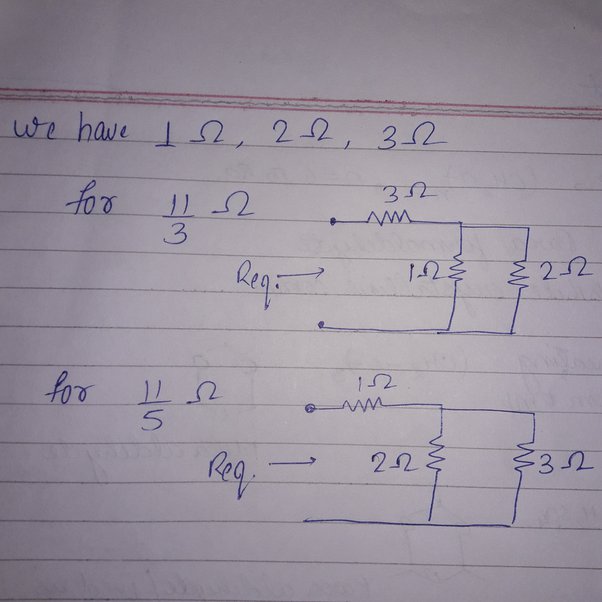To find the equivalent resistance of resistors in a circuit, you can use different combinations of resistors in series and parallel. Let’s consider the resistors with values of 1 ohm, 2 ohms, and 3 ohms.
Equivalent Resistance of 11/3 ohms:
To obtain an equivalent resistance of 11/3 ohms, you can use a combination of resistors in series and parallel. One possible combination is:
- Two resistors in series (2 ohms and 3 ohms):
- The equivalent resistance of resistors in series is the sum of their resistances.
- Req1=R2+R3=2 Ω+3 Ω=5 ΩReq1=R2+R3=2Ω+3Ω=5Ω
- This new equivalent resistor in parallel with the 1-ohm resistor:
- The formula for calculating the equivalent resistance of resistors in parallel is given by: 1/Req2=1/Req1+1/R1
- Substituting the values: 1/Req2=1/5 Ω+1/1 Ω
- 1/Req2 = 1/5 + 1
- 1/Req2 = 6/5
- Req2 = 5/6
So, combining a 2-ohm resistor and a 3-ohm resistor in series, and then connecting this combination in parallel with a 1-ohm resistor will give an equivalent resistance of 5/6 ohms, which is not exactly equal to 11/33 ohms.
Equivalent Resistance of 11/5 ohms:
To obtain an equivalent resistance of 11/5 ohms, you can use a different combination. One possible combination is:
- Two resistors in parallel (1 ohm and 3 ohms):
- The formula for calculating the equivalent resistance of resistors in parallel is given by:
1/Req3 = 1/R1 + 1/R3 - Substituting the values:
1/Req3 = 1/1 = 1/3
1/Req3 = 4/3
Req3 = 3/4
- The formula for calculating the equivalent resistance of resistors in parallel is given by:
- This new equivalent resistor in series with the 2-ohm resistor:
- The equivalent resistance of resistors in series is the sum of their resistances.
- Req4 = Req3 + R2 = 3/4 + 2 = 11/4
So, combining a 1-ohm resistor and a 3-ohm resistor in parallel, and then connecting this combination in series with a 2-ohm resistor will give an equivalent resistance of 11/4 ohms, which is not exactly equal to 11/5 ohms.
Connect 1 ohm and 2 ohm in parallel, which results 2/3 ohm. Then connect this parallel combination in series with 3 ohm to get equivalent resistance of 11/3.
